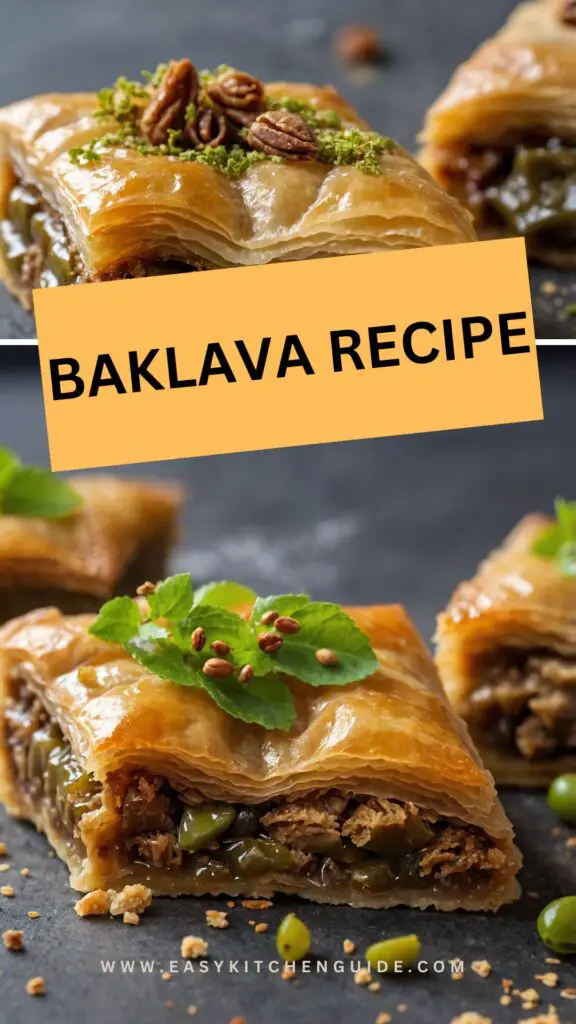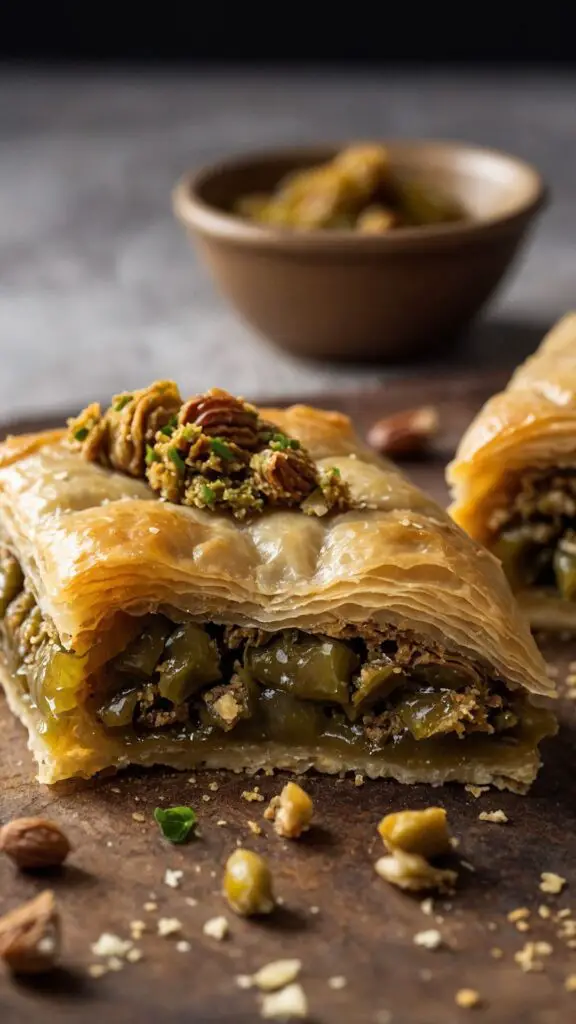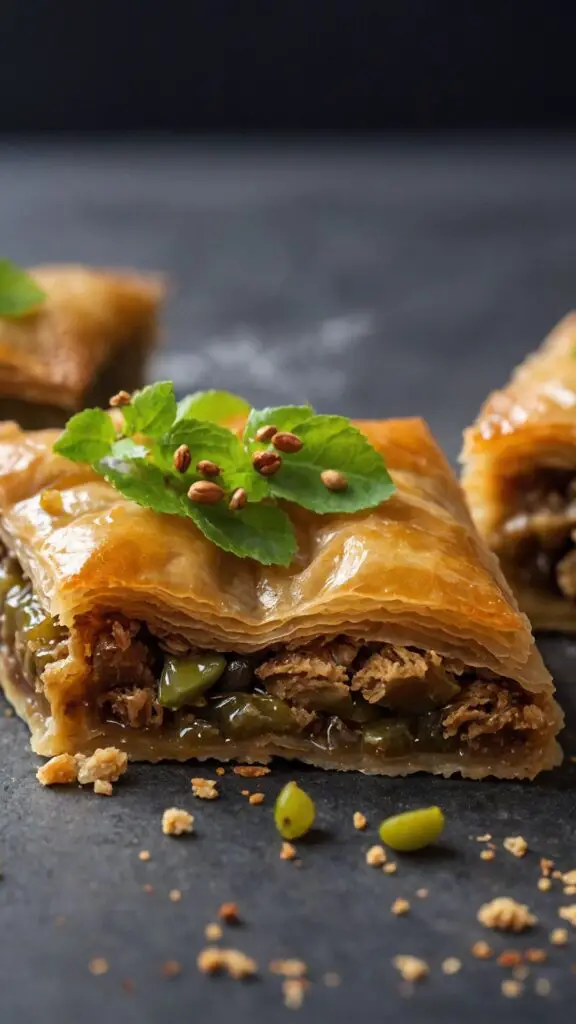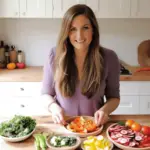Baklava is a layered pastry dessert made with thin sheets of phyllo dough, chopped nuts, and a sweet syrup.
It’s believed to have originated in the Ottoman Empire, with influences from Middle Eastern and Mediterranean cuisines.
The combination of crisp layers and honeyed filling has made it a timeless treat across many cultures.
To make baklava, start by brushing phyllo sheets with melted butter and layering them in a pan.
Add a mixture of finely chopped nuts—often walnuts or pistachios—between the layers for texture and flavor.
Once layered, cut the pastry into diamond shapes and bake until golden and flaky.
After baking, pour a warm syrup of sugar, water, lemon juice, and sometimes honey or rose water over the hot baklava.
Let it soak and cool, allowing the syrup to infuse every crisp layer.
Serve it with one of the suggested pairings to elevate the experience.

Baklava
When I first tasted baklava, it felt like I’d stepped into a world filled with exotic spices and textures. You know that feeling when food surprises you?
That’s exactly what happened. Each bite revealed a crunch, sweetness, and spices that danced on my taste buds.
This Middle-Eastern dessert is more than just a sweet treat; it’s a cultural icon with a rich history.
Originating in the Ottoman Empire, baklava has traveled far and wide, taking on different forms and flavors. You can find variations in Greece, Turkey, and many other regions across the globe. Each country adds its unique twist, making baklava a true testament to culinary creativity.
So, what is baklava exactly? Let’s break it down.
You will also like the following Dessert recipes!
- Whataburger Honey Butter Chicken Biscuit
- Best Browned Butter Chocolate Chip Cookies
- Copycat Pillsbury Fruit Pizza
What is Baklava?
Baklava is a dessert made of layers of phyllo pastry, filled with a mix of nuts and sweetened with syrup or honey.
The thin sheets of phyllo create a flaky, crispy exterior, while the nut filling adds a delightful crunch. The syrup is often infused with spices like cinnamon and cardamom, making for a complex flavor profile.
Traditionally, pistachios, walnuts, and almonds are the stars of the filling.
However, baklava is versatile, and the ingredients can vary according to personal taste and regional influences. This beautiful dessert is often cut into diamonds or squares and is a staple in festive celebrations and gatherings.
Why You’ll Love This Baklava
If you’re still on the fence, let me share why you’ll absolutely adore this baklava.
Layers of Flavor
First off, the complexity of flavors is remarkable. Each bite unveils layers of walnut, pistachio, and a touch of sweetness that’s balanced perfectly by aromatic spices.
The addition of orange blossom water adds a floral note that elevates the dish to new heights.
Texture Heaven
Imagine sinking your teeth into a flaky, buttery shell only to be met with the rich nutty filling. That contrast is divine. The crunchiness of the nuts combined with the crispiness of the phyllo creates a delightful experience.
A Labor of Love
Making baklava might seem daunting, but trust me, the process is rewarding. Each layer you add to the pan feels like you’re building something incredible.
It’s a labor of love, often made during holidays and family gatherings.
Perfect for Any Occasion
Baklava is not just for special occasions; you can enjoy it any day of the week. While it’s famous for celebrations, having it with afternoon tea or coffee can uplift your spirits.
Let’s get into the kitchen. Here are the ingredients you’ll need to create this masterpiece.
The Ingredients You Will Need To Make Baklava
To make baklava, gather the following:
For the Baklava Nut Mixture
16 oz package of phyllo pastry sheets, thawed
6 oz toasted hazelnuts, roughly chopped
1 1/2 to 2 sticks unsalted butter, melted
6 oz shelled pistachio nuts, roughly chopped
1 to 2 tbsp ground cinnamon
6 oz walnuts, roughly chopped
1/4 cup granulated sugar
A generous pinch of ground cardamom
1 tsp pure vanilla extract
For the Honey Glaze Syrup
1 cup cold water
5 whole cloves
3/4 cup granulated sugar
Juice of 1 fresh lemon
1 cup raw wildflower honey
1 tbsp orange blossom water

Directions
Step 1: Prepare the Nut Filling
In a large bowl, mix together the roughly chopped hazelnuts, pistachios, walnuts, and sugar. Add the ground cinnamon, cardamom, and vanilla extract.
Stir well to ensure that all the ingredients are thoroughly combined. The nuts should be evenly coated in the spices and sugar.
Step 2: Layer the Phyllo
Preheat your oven to 350°F (175°C). Grease a 9×13 baking dish with some of the melted butter. Carefully unroll the phyllo sheets.
They can be delicate, so handle them gently. Place the first sheet in the dish and brush it with melted butter. Repeat this process, layering about 8 sheets of phyllo, brushing each with melted butter.
Step 3: Add the Nut Filling
Evenly spread out your nut mixture over the layered phyllo. Ensure that it’s consistent across the surface for even cooking.
Step 4: More Phyllo Layers
Continue layering phyllo sheets on top of the nut mixture. Brush each layer with melted butter. Repeat this until you’ve used about 8 more sheets.
Step 5: Cut the Baklava
Using a sharp knife, carefully cut the baklava into diamond or square shapes. Make sure to cut all the way down to the bottom. This step is crucial as it allows the syrup to soak in later.
Step 6: Bake
Place the baklava in the preheated oven. Bake for about 45 minutes or until the tops are golden brown and flaky.
Step 7: Make the Syrup
While the baklava bakes, prepare the syrup. In a saucepan, combine water, sugar, cloves, and lemon juice.
Bring to a boil, then reduce the heat and let it simmer for about 10 minutes. Remove it from the heat and stir in honey and orange blossom water. This syrup needs to cool slightly.
Step 8: Pour the Syrup
Once the baklava is done baking, take it out of the oven. Immediately pour the warm syrup over the hot baklava. Let it soak for several hours or overnight for the best results.
Notes
Here are some tips to ensure your baklava turns out perfect:
- Keep the Phyllo Covered: As you work, always keep the phyllo sheets covered with a damp cloth to prevent them from drying out.
- Use Quality Nuts: Fresh, high-quality nuts make a big difference. Toasting them at home can add an additional layer of flavor.
- Experiment with Spices: Feel free to adjust the spices to match your preference. Some people enjoy adding more cinnamon or cardamom.
- Don’t Skimp on Butter: Each layer needs an ample amount of melted butter to achieve that flaky texture. Don’t hesitate to brush enough on each one.
- Cut Before Baking: Always cut before baking. This prevents the layers from separating when it’s cooked.
Storage Tips
Baklava can be stored at room temperature in an airtight container. It can last for about a week. For longer storage, keep it in the fridge for up to two weeks.
If you want to freeze it, wrap it tightly and store it in the freezer for up to a month. Let it thaw at room temperature before serving.
Nutrition Information
Baklava Recipe Nutrition Facts
Serving Suggestions
When serving baklava, you have a few fantastic options to enhance the experience:
- Pair with a Strong Coffee: The bitterness of coffee highlights the sweetness of baklava. It’s a classic combo that’s sure to please.
- Serve with Ice Cream: Adding a scoop of vanilla ice cream creates a contrast of warm and cold. The creaminess helps balance the sweet and crunchy baklava.
- Top with Fresh Fruits: Placing some sliced fruits like berries or citrus can add freshness. This contrast enriches your palate.
- Add a Dusting of Powdered Sugar: A light dusting on the top not only makes it visually appealing but adds an extra touch of sweetness.
- Include a Dollop of Yogurt: Thick yogurt, perhaps sweetened with honey, introduces a tangy note that contrasts well with the baklava.
These suggestions offer a variety of textures and flavors to create a lovely dessert experience.

What Other Substitutes Can I Use in Baklava?
Getting creative in the kitchen is always rewarding. Here are some substitutes you can use in your baklava:
- Other Nuts: Cashews or macadamia nuts can easily replace the walnuts or pistachios. They provide a unique flavor.
- Almond Flour: For those who prefer less crunch, almond flour can substitute for the coarsely chopped nuts, giving a smooth texture.
- Cinnamon Alternatives: Nutmeg or allspice can step in for cinnamon, introducing different warm notes to your baklava.
- Maple Syrup: Replace honey with maple syrup for a different sweetness that’s also vegan-friendly.
- Different Sweeteners: If you’re looking to cut down on sugar, consider using stevia or monk fruit sweetener. They work well in the syrup.

Baklava Recipe
Equipment
Ingredients
For the Baklava Nut Mixture
- 16 oz package of phyllo pastry sheets thawed
- 6 oz toasted hazelnuts roughly chopped
- 1 1/2 to 2 sticks unsalted butter melted
- 6 oz shelled pistachio nuts roughly chopped
- 1 to 2 tbsp ground cinnamon
- 6 oz walnuts roughly chopped
- 1/4 cup granulated sugar
- A generous pinch of ground cardamom
- 1 tsp pure vanilla extract
For the Honey Glaze Syrup
- 1 cup cold water
- 5 whole cloves
- 3/4 cup granulated sugar
- Juice of 1 fresh lemon
- 1 cup raw wildflower honey
- 1 tbsp orange blossom water
Instructions
Step 1: Prepare the Nut Filling
- In a large bowl, mix together the roughly chopped hazelnuts, pistachios, walnuts, and sugar. Add the ground cinnamon, cardamom, and vanilla extract.
- Stir well to ensure that all the ingredients are thoroughly combined. The nuts should be evenly coated in the spices and sugar.
Step 2: Layer the Phyllo
- Preheat your oven to 350°F (175°C). Grease a 9×13 baking dish with some of the melted butter. Carefully unroll the phyllo sheets.
- They can be delicate, so handle them gently. Place the first sheet in the dish and brush it with melted butter. Repeat this process, layering about 8 sheets of phyllo, brushing each with melted butter.
Step 3: Add the Nut Filling
- Evenly spread out your nut mixture over the layered phyllo. Ensure that it’s consistent across the surface for even cooking.
Step 4: More Phyllo Layers
- Continue layering phyllo sheets on top of the nut mixture. Brush each layer with melted butter. Repeat this until you’ve used about 8 more sheets.
Step 5: Cut the Baklava
- Using a sharp knife, carefully cut the baklava into diamond or square shapes. Make sure to cut all the way down to the bottom. This step is crucial as it allows the syrup to soak in later.
Step 6: Bake
- Place the baklava in the preheated oven. Bake for about 45 minutes or until the tops are golden brown and flaky.
Step 7: Make the Syrup
- While the baklava bakes, prepare the syrup. In a saucepan, combine water, sugar, cloves, and lemon juice.
- Bring to a boil, then reduce the heat and let it simmer for about 10 minutes. Remove it from the heat and stir in honey and orange blossom water. This syrup needs to cool slightly.
Step 8: Pour the Syrup
- Once the baklava is done baking, take it out of the oven. Immediately pour the warm syrup over the hot baklava. Let it soak for several hours or overnight for the best results.
Notes
- Keep the Phyllo Covered: As you work, always keep the phyllo sheets covered with a damp cloth to prevent them from drying out.
- Use Quality Nuts: Fresh, high-quality nuts make a big difference. Toasting them at home can add an additional layer of flavor.
- Experiment with Spices: Feel free to adjust the spices to match your preference. Some people enjoy adding more cinnamon or cardamom.
- Don’t Skimp on Butter: Each layer needs an ample amount of melted butter to achieve that flaky texture. Don’t hesitate to brush enough on each one.
- Cut Before Baking: Always cut before baking. This prevents the layers from separating when it’s cooked.
Frequently Asked Questions
1. Can baklava be made ahead of time?
Absolutely! Baklava can be prepared in advance and stored in an airtight container. The flavor improves overnight as the syrup seeps into the pastry.
2. What’s the best way to cut baklava?
When cutting baklava, use a sharp knife and cut through all the layers before baking. This allows the syrup to penetrate every layer later.
3. Can I make baklava without nuts?
Yes, you can create nut-free baklava using alternatives like crushed graham crackers or seeds. They won’t replicate the same texture, but they will still be delicious.
4. What is the purpose of soaking baklava in syrup after baking?
Soaking in syrup is essential for flavor. It adds sweetness and moisture, ensuring the baklava stays fresh and tender.
5. Can I use store-bought phyllo dough?
Certainly! Store-bought phyllo dough is convenient and works just as well. Make sure it’s thawed completely before use.
6. How do I know when baklava is done baking?
The baklava is done when it has a golden brown color and the edges look crisp. A nice aroma filling the kitchen is also a good indicator!
Conclusion
Just like that first sweet bite of baklava, I hope you found this journey through its flavors and preparation both enlightening and appetizing. This traditional dessert isn’t just about the ingredients; it’s a creation filled with love and history, bringing people together across cultures.
Whether you’re serving it at a gathering or savoring it with a cup of coffee, baklava embodies a sense of comfort and delight.
So, roll out your phyllo, grab those nuts, and dive into this delicious adventure. Trust me, once you make this baklava, it will earn a permanent spot in your kitchen repertoire. Happy baking!
You’ll also like these latest recipes!
- How to cook Healthy Chicken Gnocchi Soup
- 15 Minute Meal Prep Breakfast Sandwiches
- Easy Homemade Yellow Curry Paste Recipe
My name is Lori Walker. I’m a registered dietitian, food blogger and food enthusiast. I share easy healthy, delicious recipes on my blog and review necessary kitchen items. The recipes I share take less… Read more
